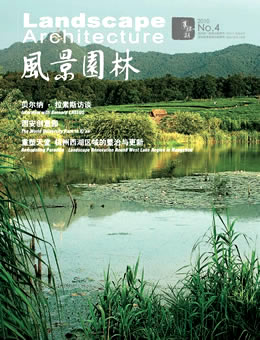吴欣/美国西南大学亚洲艺术和建筑史客席教授
WU Xin is a Visiting Professor of Asian Art and Architecture History at Southwestern University in
正如标题“百家山水言”所强调的,本专栏力图展示中国历史上与风景园林有关的多样化的山水观。从这一期开始,我们将着重对造园盛行的明清时期进行省思。风景园林研究决不能脱离中国历史和文化(尤其是艺术与文学)。这期的文章将对清中期新儒家文人的园林观进行探讨;下两期(2010.10-12)的文章则将分别从绘画和小说的角度来解读明清园林。

自2009年担任本专栏主持以来,我为每期的文章写导读,在这里有幸作为本期文章的作者自我介绍一下。我现在任美国西南大学亚洲艺术和建筑史客席教授;从2002年到2009年,曾任哈佛大学橡树园研究中心亚洲项目总协调人和当代景观设计收藏馆馆长。我目前的研究兴趣主要在于空间的文化建构,和中国传统书院中山水-教育-历史之间的互动关系;已在欧美和中国的出版物上发表了多篇关于中国山水文化史的学术论文。我第二个研究方向是当代景观设计。自2009年以来同时主持“当代景观评论”专栏;出版的英文版新书名为《重塑现代型:家园与花园》(2008)。
“园林为文化的记忆”一文研究清岳麓书院学人所建的书院八景。这些园林无疑是文人园;然而它们看起来与成为“文人园”典范的苏州园林截然不同。书院成立于宋,自此“格物致知”被尊为新儒家认识论的根本,园林和景观成为书院教育不可或缺的一环。山水对于书院的重要性不在于其休闲作用,而在于其作为一个活的文化记忆的载体的存在。这种活的记忆,不是通过造型元素,而是通过学习人们的日常活动和与自然万物的互动来保持的。也就是说,是一种活着的文化使这些书院园林延续了上百年。这种活的记忆为持续中的渐变提供了可能,包容了宋明之际审美品位由道德性向欣赏性的转变;同时也令我们好奇地思考,是否这些园林在清代又或刻画了文人们对濒危的社会地位的不满。书院八景会否可能是文人们借用来进行文化抗争的一种表达形式,像我们已经在专栏中读到过的发生在唐宋之交的故事那样(见2009.06专栏包华石文章)。

最后,我们有必要将园林的兴盛置于明清中国社会的大背景之下重新审思。一方面,明清之际孕育了重要的经济发展和社会变化,富庶的江南成为城市文化和消费文化的中心。另一方面,当时在艺术和文学中占统治地位的形式主义大大地窒息了中国文化的创造性。在中华富强的今天,对幸存的历史性园林的保护是毋庸置疑的。更为紧迫的问题是如何保持中国特有的风景/景观/园林传统的活力——也就是说如何弘扬一种文化而非一种形式。就此,让我们复苏“山水”的灵性。
As highlighted by the title of this column, we strive to present various views of shanshui in relation to gardens and landscapes in Chinese history. Starting from this issue, we will offer a scrutiny of the Ming-Qing period when garden-making reached a new height. It is important to note that studies on gardens and landscapes cannot be separated from Chinese history and culture (art and literature in particular). The article of this issue will examine what the idea of garden meant to neo-Confucian scholars; while the two articles in the following October issue will link the idea of garden to painting and novel.
I have written introductions for each issue as the host of this column since 2009, here I am glad to present myself as the author of this issue’s article. I am now a Visiting Professor of Asian Art and Architecture History at Southwestern University in America. From 2002-2009, I was the Coordinator of Asian Programs and Founding Curator of Contemporary Landscape Collection at Dumbarton Oaks / Harvard University. My current research interest is on the cultural construction of space, and reciprocal interaction between Shanshui, education and history in Chinese raditional academies. I have published in US, European and Chinese journals on the history of Chinese gardens and landscape culture history. I am also a specialist of contemporary landscape architecture, hosting another column
“Landscape Design Criticism” (2009-); my newest book is entitled Reconstruction of Modernity: Patricia Johanson’s House & Garden Commission (2008).The following article, “Gardens as Cultural Memory”, focuses on the gardens of eight-views built and used by the scholar community at Yuelu Academy in Qing period. These were no doubt “scholar’s garden”; yet their appearance differed from Suzhou gardens, which have become the classical images of Chinese scholar’s garden. Gardens and landscapes have been an indispensable part in the pedagogy of the Academy since its foundation in Song Dynasty, when “ge-wu zhi-zhi” was established as the core of neo-Confucian epistemology. The importance of engagement with shanshui laid not in leisure but in its ability to encapsulate a living cultural memory of the Academy. Such living memory was maintained not through the formal elements, but through scholar’s daily activities and interaction with the ten-thousand-things. In other words, a living culture kept these gardens alive for centuries. While such living memory enabled transformations within continuity by allowing a changing attitude from ethical to aesthetical appreciation from Song to Ming, we also wonder whether it portrayed a resistance of literati to their changing social status in Qing Dynasty. Could these gardens of eight-views be a form of cultural rectification enacted by the literati, as we have seen at the turn of Tang and Song (see article by Martin Powers,2009.06).
Finally, it is necessary to re-think about the boom of gardens against a broader picture of Ming-Qing China. On the one hand, Ming-Qing marked a period of major economic development and social changes, with the rich Jiangnan region as the center of urbanism and consumerism. On the other hand, the overwhelmingly formalism in art and literature greatly suffocated Chinese creativity. Today, there is no doubt for the safe-guarding of surviving historical gardens in a prosperous China. A pressing question would be how to keep the Chinese tradition of garden and landscape alive; that is to reconnect with the culture instead of the form. To this end, let us revivify the spirit of Shanshui.
 《风景园林》2010第4期导读
《风景园林》2010第4期导读
Leave a Reply